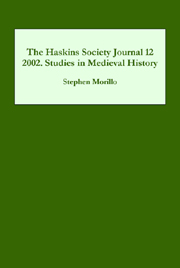Book contents
- Frontmatter
- Contents
- Editorial Note
- Abbreviations
- 1 Religious Houses and the Laity in Eleventh- to Thirteenth-Century England: An Overview
- 2 Two Yorkshire Historians Compared: Roger of Howden and William of Newburgh
- 3 The Rise and Fall of the Anglo-Saxon Law of the Highway
- 4 Consilium et Auxilium and the Lament for Æschere: A Lordship Formula in Beowulf
- 5 Royal Succession and the Growth of Political Stability in Ninth-Century Wessex
- 6 From Anglorum basileus to Norman Saint: The Transformation of Edward the Confessor
- 7 St þorlákr of Iceland: The Emergence of a Cult
- 8 Reshaping the Past on the Early Norman Frontier: The Vita Vigoris
- 9 The Appeal to Original Status in the Angevin Region (Eleventh–Twelfth Centuries)
- 10 Dudo of St. Quentin as an Historian of Military Organization
1 - Religious Houses and the Laity in Eleventh- to Thirteenth-Century England: An Overview
Published online by Cambridge University Press: 12 September 2012
- Frontmatter
- Contents
- Editorial Note
- Abbreviations
- 1 Religious Houses and the Laity in Eleventh- to Thirteenth-Century England: An Overview
- 2 Two Yorkshire Historians Compared: Roger of Howden and William of Newburgh
- 3 The Rise and Fall of the Anglo-Saxon Law of the Highway
- 4 Consilium et Auxilium and the Lament for Æschere: A Lordship Formula in Beowulf
- 5 Royal Succession and the Growth of Political Stability in Ninth-Century Wessex
- 6 From Anglorum basileus to Norman Saint: The Transformation of Edward the Confessor
- 7 St þorlákr of Iceland: The Emergence of a Cult
- 8 Reshaping the Past on the Early Norman Frontier: The Vita Vigoris
- 9 The Appeal to Original Status in the Angevin Region (Eleventh–Twelfth Centuries)
- 10 Dudo of St. Quentin as an Historian of Military Organization
Summary
Testificacio primi doni
R. de Gant omnibus ecclesie filiis salutem. Notum sit vobis me presentem fuisse ubi Gilbertus comes frater meus fecit diuisam suam in extrema egritudine sua coram hominibus suis qui presentes fuerunt et dedit Ecclesie Brid' cum corpore suo in liberam etperpetuam elemosinam Burtonam cum omnibus suis pertinenciis …
Hec omnia confirmauit eidem ecclesie cum libertatibus que sunt in Carta sua et precepit mihi sicut fratri suo et homini ut ego ad scribendum et ad sigillandum presens essem cumhominibus suis qui tunc erant cum eo et cum lecte essent carte de hiis coram nobis per consilium et assensum eorundem hominum suorum de manu mea accepit. Johannes Camerarius sigillum et sub testimonio nostro sigillauit eas de hac re testis sum ego et si aliquis contradicere uoluerit paratus sum ego de hoc facere quicquid pertinet ad testem legittimum. Valete.
A benefaction to a religious house, even by a lay magnate such as de Gant, and even to the family's foundation whose inmates had been described in proprietary fashion by Gilbert de Gant, earl of Lincoln, as canonici mei, was thus a momentous occasion, inscribed in local memory. In this case, the occasion washeightened by death-bed anxiety and the congregation of the lord's followers. Exceptional it certainly was, therefore, in the context of the multitudinous benefactions to religious houses. With few exceptions, English charters notifying benefactions to religious houses are cursory, indeed little more than notifications.
- Type
- Chapter
- Information
- The Haskins Society Journal 122002 - Studies in Medieval History, pp. 1 - 14Publisher: Boydell & BrewerPrint publication year: 2003

